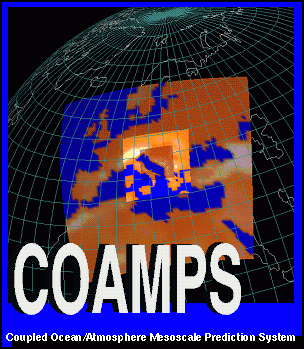Overview
What is COAMPS?
COAMPS is a acronym for "The Coupled Ocean/Atmosphere Mesoscale Prediction
System" and it represents an analysis-nowcast and short-term (up to 48 hours)
forecast tool applicable for any given region of the earth. COAMPS includes an atmospheric
data assimilation system comprised of data quality control, analysis, initialization, and
nonhydrostatic atmospheric model components and a choice of two hydrostatic ocean models.
The atmospheric component of COAMPS can be used for real-data simulations, the analysis
can use global fields from the Navy Operational Global Atmospheric Prediction System
(NOGAPS) or the most recent COAMPS forecast as the first-guess. Observations from
aircraft, rawinsondes, ships, and satellites are blended with the first-guess fields to
generate the current analysis. For the idealized experiments, the initial fields are
specified using an analytic function and/or empirical data (such as a single sounding) to
study the atmosphere in a more controlled and simplified setting. The atmospheric model
uses nested grids to achieve high-resolution for a given area and contains
parameterizations for subgrid scale mixing, cumulus parameterization, radiation, and
explicit moist physics. Typical mesoscale phenomena that COAMPS has been applied to
includes mountain waves, land-sea breezes, terrain-induced circulations, tropical
cyclones, mesoscale convective system, coastal rainbands, and frontal systems.
The COAMPS model domain typically covers a limited area on the earth. The model grid
size, usually referred to as grid resolution, can range from a few hundred kilometers
(synoptic scale) down to approximately one meter when using the large-scale eddy (LES)
mode. The actual dimensions used depend on the scale of the phenomena the user is
interested in simulating. The model dimensions can be set so as to produce any rectilinear
pattern and can also be rotated to align with any surface feature, such as the terrain or
a coastline. COAMPS can be run with any number of nested grids, with the grid resolution
in any mesh one-third that of the next coarser mesh.
COAMPS also contains an option to utilize either the Modular Ocean Model (MOM) or the
Princeton Ocean Model (POM). In a fully-coupled mode, the atmospheric and ocean models can
be integrated simultaneously so that the precipitation and the surface fluxes of heat,
moisture, and momentum are exchanged across the air-ocean interface every time step.
Optionally, the atmospheric model or either of the ocean models can be used as a
stand-alone system.
Restriction for COAMPS usage
COAMPS is developed to support Tactical Naval operations and R&D usage. In order to
get a copy of COAMPS source code, organizations other than those within the Department of
Defense (DOD), are required to sign NRL's Memorandum of Agreement.
What kind of experience is needed to use COAMPS
The users should have basic knowledge of numerical weather prediction, an understanding
of atmospheric science in the area of numerical weather prediction, some knowledge of UNIX
operating system and Fortran 77 programming language.
Hardware and software requirement for COAMPS
COAMPS is a portable atmospheric modeling system (the ocean model coupling is under
development, not for release now), that can currently be run on most of the major vendor
machines such as Cray, SGI, DEC ALPHA, SUN and HP workstations. Future releases will
include the ability to run on the mpp type machines.
- Memory requirement: it depends on how big of a domain, number of nested domains, and
number of grid points that one intend to run COAMPS with. The bench case which used the
test dataset came with the COAMPS source code required the following amount of memory for
the forecast model:
- Domain size:
- coarse domain: 61x61x30.
- nested domain: 61x61x30.
- full physics.
- On the SGI R10000 (32 bits mode, 16 kbytes page size), this run required about86
megabytes of memory.
- On the CRAY YMP, this run required 23 megabytes of memory.
- The COAMPS analysis uses less memory than the forecast. As a first-cut estimation, one
can use the Fortran program memory.f to obtain the COAMPS memory requirement for your grid
set up. More accurate memory requirement can be obtained by actually running COAMPS.
- Disk space: for standard outputs, COAMPS requires about 15.2 megabytes disk space per
output time but varies enormously based on output fields selected.
- CPU time: you can use the following formula to get an estimation (in second). More
accurate cpu time required can be obtained by actually running COAMPS.
- cpu time (per domain) = CF * number of grid points * number of model time steps
- where
CF is the computation factor, this number is about 1.6e-5 second on
one processor CRAY C90 and 6.7e-5 second on one processor SGI R10000
machines.
number of grids = (number of grid points in X direction) x
(number of grid points in Y direction) x
(number of grid points in Z direction)
number of model time steps = forecast time in second /
model time steps
usually, the coarse domain model time steps in seconds is about 3
times the coarse domain grid size in kilometers. The nested domain
time step is 3 times smaller than the next coarser mesh (for example
if the time step used in coarse domain is 360 second, the
nested domain 1 has a time step of 120 second, the nested domain 2
has a time step of 40 second ... etc.).
- Software requirement (Fortran and C compiler): Most of the COAMPS source code is written
in Fortran 77. A few subroutines are written in C. COAMPS use dynamic memory allocation
extensively throughout the code which is not an ANSI Fortran 77 standard. In oder to
compile COAMPS, one needs to use a Fortran 77 compiler that allows dynamic memory
allocation or use the Fortran 90 compiler.
Please send your questions and comments to Ms. Chen
(chen@nrlmry.navy.mil)
Last Updated: Nov 20 1998


| First Page | Prev Page | Next Page | Back
to Text |
